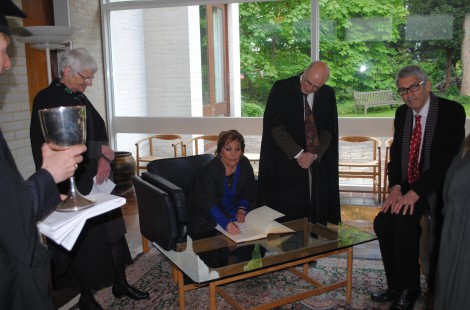
It is with great sadness that the College has learned today of the death of Dame Paula Rego who was elected to an Honorary Fellowship of Murray Edwards College in 2013.
Dame Paula Rego was born in Lisbon in 1935. Her liberal family both recognised and opposed the confines of living in dictator-led Portugal and, as such, sent Rego to a finishing school in Kent, when she was 16. From the finishing school, she moved to The Slade School of Fine Art and studied there from 1952-1956. There she met Victor Willing; the couple were married in 1959 and had three children.
Initially, Rego principally made political collages that challenged authority and power structures. Whilst in London she started to exhibit her work as part of The London Group, in which she was the only female artist at the time to show paintings alongside the likes of David Hockney and Frank Auerbach. In 1965, she took part in a group show at the Institute of Contemporary Arts London (ICA), called Six Artists, and in the same year had her first solo show in Lisbon at the Sociedade Nacional de Belas Artes. These two exhibitions established Rego as a political and subversive artist.
By the 1970s, Rego had settled in London but continued to be heavily influenced by Portuguese politics, culture, and folklore. Many of her paintings from the 1980s were highly erotic, exploring the complexities of female sexuality and the Freudian family drama. By this point she had moved away from collage work completely and focused on figurative depictions using oil paint with clearer indications of narratives. She became the first Associate Artist of the National Gallery, an artist-in-residence scheme through which she could undertake collaborative works with institutional support. During the residency she created a series of paintings and prints based on nursery rhymes, a long-standing favourite topic of hers. By this point Rego was a fully-fledged public figure in British cultural life, though her work always remained intimately involved with the politics and mythology of Portugal.
Later in the 1980s, Rego started to work regularly with life models. In particular, the artist has worked continuously with Lila Nunes who she uses as a stand in figure for her own self. Nunes came into Rego's life as a nurse in 1985 to help her take care of her husband, Willing in the final few years of his life. After many years struggling with MS, Willing died in 1988. Nunes remained with Rego as her friend, artist companion, and primary model.
Rego continued to work and paint prolifically throughout the 1990s and 2000s. By this point she had made the transition from paint to pastel. During the 2000s she has made many print and drawing series. One notable series made in 2007 focuses entirely on the artist's long standing battle with depression.
Rego's work continued to challenge political narratives and to explore contemporary issues particularly those affecting women, such as reproductive rights and the refugee crisis. Her work is inspirational for all young artists in its thoroughness and rigour in the combination of many different influences and styles.
26 January 1935 – 8 June 2022